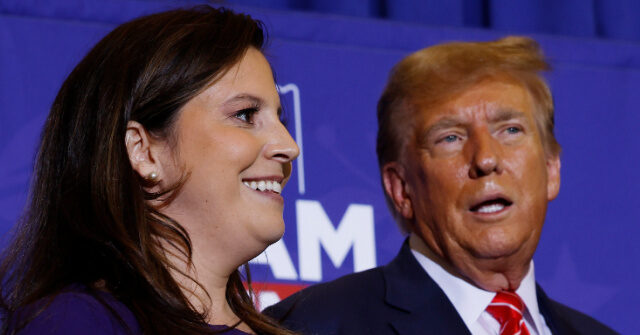Top Republicans are increasingly convinced that former President Donald Trump’s influence is significantly boosting voter turnout in down-ballot New York House races, which could play a pivotal role in determining the control of the House of Representatives in the upcoming 2024 elections. According to reports from sources familiar with internal GOP assessments, the party has seen a remarkable increase in voter participation in key battleground districts compared to previous election cycles, particularly the 2022 midterms. These districts, which previously contributed to Republican gains, are now expected to be crucial in both retaining current Republican seats and potentially flipping Democratic ones. Early vote data indicates that certain districts are outperforming historical turnout rates by as much as 50 percent, suggesting that Trump’s enduring popularity continues to energize Republican voters in New York.
House Conference Chair Elise Stefanik (R-NY) is leading the election efforts, channeling nearly $3 million into early voting initiatives through various party funds, which include contributions from the National Republican Congressional Committee (NRCC) and the New York Republican Party (NYGOP). Stefanik’s previous ground game during the 2022 elections is credited for enabling Republicans to achieve a majority in the House, thus staunching the Biden administration’s legislative agenda. She emphasizes the importance of maintaining momentum, urging all Republican supporters to participate actively in early voting and ensure their networks are mobilized. Stefanik’s perspective is that New York could play a critical role in the presidential race, as well as in determining the overall control of the House.
Observations from Alex DeGrasse, executive director of Team Elise, suggest that House Democrats, particularly those led by Governor Kathy Hochul, are facing significant challenges. DeGrasse points to a record turnout of Republican early voters, coupled with the diminishing effectiveness of the Democrats’ vote-by-mail strategy, indicating a notable shift in voter sentiment. Notably, regions like Long Island and the Hudson Valley are showing promising trends for Republicans, as well as in upstate New York, where Republicans appear to be gaining ground in traditionally Democratic tiers. He highlights the critical need for intensified mobilization efforts among Republicans to sustain this momentum and secure victories in both defensive positions and new targets.
Current early voting data illustrates a mixed bag of results for GOP candidates across various districts, with some Republicans outperforming others in margins compared to 2022. For instance, while Rep. Nicholas LaLota (District 1) leads by 9.24%, other candidates are seeing tighter races. Noteworthy is the substantial margin shifts for several candidates, reflecting the heightened enthusiasm among Republican voters. The data underscores a clear trend: Republicans are gaining a favorable edge over Democrats in early voting participation, which could translate into a significant electoral advantage as Election Day approaches.
Democratic advisers appear increasingly alarmed by the favorable early voting statistics for Republicans. Reports indicate that in key districts designated as battlegrounds for Democrats, the ratios of early voters skew negatively for their party. The emerging narrative among Democrats suggests that they are attempting to downplay these unfavorable numbers by claiming that these early Republican voters would have voted regardless; nevertheless, numbers show that a smaller proportion of early voters are identifying as Democrats, signaling a potential vulnerability for the party. This situation is exacerbated by the fact that Democrats generally hold a significant registration advantage, yet recent statistics reveal a troubling trend for their ranks in terms of voter engagement.
Trump himself is actively involved in rallying support for Republicans in New York, emphasizing the potential of these races to shift the balance of power in Congress. His recent tele-rally, which reached out to a substantial network of supporters, aimed to encourage early voting participation, highlighting the prevalent issues in urban areas of New York as part of his rallying cry. He notes the drastic change in voter interest and participation, particularly among less frequent voters, noting that they are coming out to support Republican candidates in unprecedented numbers. As the election cycles continue to unfold, the stakes remain high for both parties as they navigate the shifting political landscape and work to galvanize their respective bases ahead of a pivotal election.

